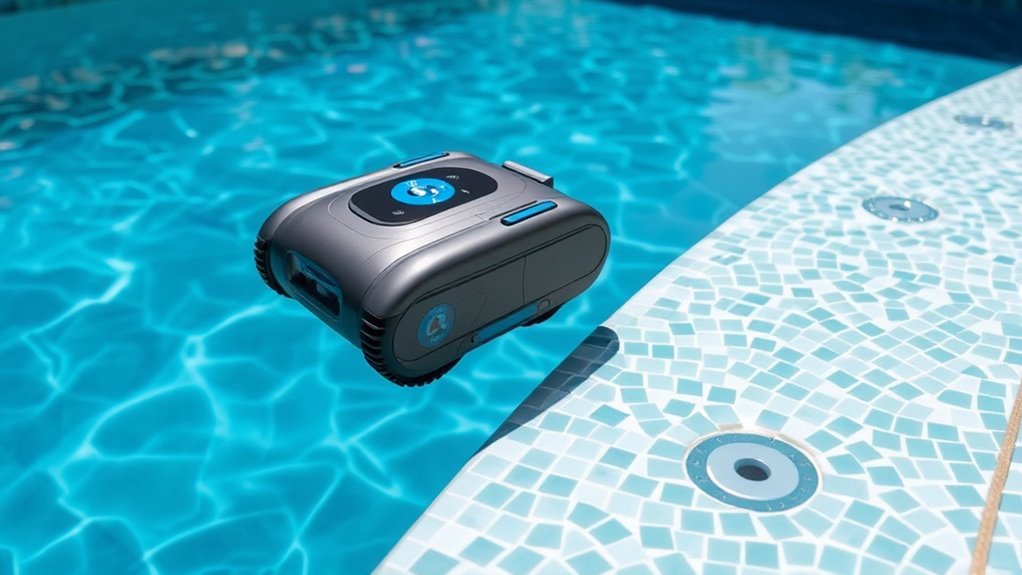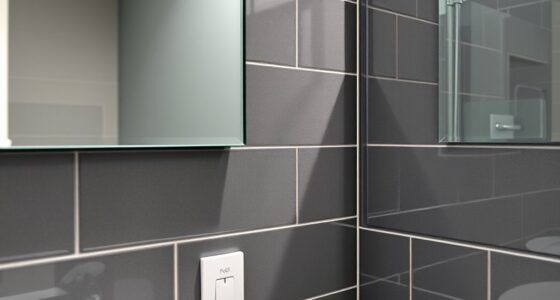Robotic cleaners are portable, easy to use, and excel at reaching tricky spots like pool edges, making them a flexible choice for maintaining your edge pool’s cleanliness. In-floor systems are built into your pool’s structure, offering thorough, consistent cleaning but at a higher cost and installation effort. Depending on your budget and pool size, either option could work. Keep exploring to find out which solution suits your needs best.
Key Takeaways
- Robotic cleaners excel at navigating tight corners and targeting debris in edge pools, while in-floor systems provide uniform coverage of larger areas.
- Robotic cleaners are more affordable, portable, and easier to install compared to the complex, higher-cost in-floor systems.
- In-floor systems offer automatic, integrated cleaning built into the pool structure, reducing manual effort but requiring professional installation.
- Robotic cleaners are simpler to maintain with regular filter and brush upkeep, whereas in-floor systems need inspection of embedded piping and nozzles.
- Effectiveness varies based on debris type and pool shape; robots handle fine debris and tricky spots better, while in-floor systems quickly cover broad surfaces.
Overview of Robotic Pool Cleaners

Robotic pool cleaners have become a popular choice for maintaining clean pools with minimal effort. You simply program them, and they handle the cleaning process on their own. These devices are equipped with advanced sensors that help them navigate your pool efficiently, reaching corners and difficult spots. They typically come with brushes, filters, and scrubbing features to remove dirt, algae, and debris from the surfaces. Most models are designed for easy setup and maintenance, making pool cleaning less of a chore. Robotic cleaners operate independently, saving you time and energy. They are suitable for various pool sizes and shapes, including edge pools. With regular use, they help keep your pool water clear and inviting without the need for manual scrubbing or vacuuming. Additionally, incorporating high-quality navigation technology can significantly improve their efficiency and coverage during cleaning sessions.
In-Floor Cleaning System Features and Benefits

In-floor cleaning systems are built into the pool’s structure, providing automated maintenance directly at the source. They actively sweep debris from the pool floor and walls, ensuring thorough cleaning without manual effort. These systems are customizable, so you can target specific areas needing extra attention. Here are some key features and benefits: 1. Automatic Operation: Clean your pool regularly without lifting a finger. 2. Targeted Cleaning: Focus on high-traffic zones for maximum efficiency. 3. Water Circulation: Improve water quality by promoting better circulation. 4. Low Maintenance: Reduce the need for manual vacuuming and chemical balancing. Additionally, integrated wall organization systems can help you optimize space for pool accessories and maintenance tools.
Cost Analysis and Installation Considerations

When evaluating cleaning options for your in-ground pool, cost and installation requirements play a essential role in decision-making. Robotic cleaners typically have a lower upfront cost, often ranging from $300 to $1,200, and are easy to install, usually requiring only a power outlet and a dedicated cable. In contrast, in-floor systems involve higher initial expenses, often between $3,000 and $7,000, due to the cost of installed pop-up heads and plumbing work. Installation of in-floor systems can be complex, requiring professional contractors and significant modifications to your pool’s structure. Robotic cleaners offer flexibility, can be stored easily, and are less invasive. In-floor systems, while more expensive initially, are integrated into the pool design, potentially reducing long-term cleaning costs. Additionally, installation complexity can influence the overall value and maintenance of your pool system.
Effectiveness in Edge Pool Cleaning

Edge pool cleaning requires precise coverage to prevent debris buildup in hard-to-reach areas, making effectiveness a crucial factor in choosing a system. Both robotic cleaners and in-floor systems excel in different ways.
Here’s what to weigh:
- Coverage Accuracy – Robotic cleaners navigate the entire pool, targeting tricky corners effectively.
- Cleaning Speed – In-floor systems often clean larger areas faster with their fixed nozzles.
- Debris Removal – Robots can pick up fine debris and algae more thoroughly in tight spots.
- Consistency – In-floor systems deliver uniform cleaning for the entire pool surface without missing spots.
Your choice depends on your pool’s shape and debris type, but effectiveness remains key to maintaining a pristine edge pool.
Maintenance and Operational Ease

Maintaining robotic cleaners and in-floor systems involves different levels of effort and complexity, which can considerably impact your convenience. Robotic cleaners typically require regular battery charging, filter cleaning, and occasional brush replacement, but their maintenance is straightforward and quick. In-floor systems, on the other hand, demand more extensive upkeep, including inspecting and servicing the embedded piping and moving parts, which often involves professional help. Operating a robotic cleaner is simple—just turn it on and let it do its job. In-floor systems usually need manual activation and periodic inspections to ensure the nozzles and pumps function properly. Overall, robotic cleaners offer easier, less time-consuming maintenance, making them more convenient for regular use. In-floor systems tend to be more involved, requiring more effort and technical knowledge.
Making the Right Choice for Your Pool

Choosing between robotic cleaners and in-floor systems depends on your pool’s specific needs, your maintenance preferences, and your budget. To make the right choice, consider these factors:
Selecting the right pool cleaning system depends on your pool’s needs, maintenance style, and budget.
- Cleaning Frequency: Do you want regular, automated cleaning or occasional deep cleans?
- Ease of Use: Are you comfortable managing a robotic cleaner or prefer a set-it-and-forget-it in-floor system?
- Cost: What’s your upfront budget versus long-term expenses?
- Pool Size & Shape: Larger or uniquely shaped pools may benefit from the coverage robotic cleaners provide, while in-floor systems are ideal for uniform cleaning in standard designs.
- Dog Names: If you’re a pet owner, think about dog names that fit your lifestyle and backyard environment, which can influence your choice of pool cleaning system.
Assess your priorities carefully to select the system that best fits your pool maintenance style and financial plan.
Frequently Asked Questions
How Long Do Robotic Cleaners Typically Last Before Replacement?
Robotic cleaners usually last around 3 to 5 years before needing replacement, depending on usage and maintenance. You should regularly clean and inspect your robotic cleaner to extend its lifespan. Proper care, such as rinsing filters and checking for damage, guarantees peak performance. If you notice it’s not cleaning effectively or has frequent malfunctions, it might be time to contemplate a new one within that timeframe.
Are In-Floor Systems Compatible With All Pool Shapes and Sizes?
Think of in-floor systems as flexible dance partners for your pool—they adapt beautifully to various shapes and sizes. Most systems are designed to fit standard and custom pools, ensuring thorough cleaning no matter the design. However, some unique or highly irregular shapes might need tailored solutions. Before installing, check with the manufacturer to confirm compatibility. You’ll find that these systems can seamlessly keep your pool sparkling, regardless of its form.
What Are the Energy Consumption Differences Between the Two Systems?
In-floor systems generally use more energy than robotic cleaners because they operate continuously, powering pop-up heads and pumps to clean the entire pool floor and walls. Robotic cleaners are more energy-efficient since they run only when cleaning, often on a timer. If you want to save on energy costs, a robotic cleaner might be the better choice. However, in-floor systems can offer more consistent, hands-free cleaning.
Can Robotic Cleaners Handle Heavy Debris and Algae?
Sure, your robotic cleaner can tackle light debris, but when it comes to heavy leaves or stubborn algae, don’t expect it to be your hero. It’s like asking a tiny vacuum to clean up a hurricane. In-floor systems, on the other hand, are built for the big messes, sweeping up debris and algae with industrial strength. So, if you’re dealing with the heavy stuff, don’t rely solely on your robotic helper.
What Warranties or Support Options Are Available for Each System?
You’ll find that robotic cleaners often come with warranties ranging from one to three years, which cover parts and repairs, and many brands offer customer support and replacement parts. In-floor systems usually have longer warranties, sometimes up to five years, with professional support options for installation and maintenance. Always check the specific manufacturer’s warranty details and support services to guarantee you get reliable coverage and assistance for your system.
Conclusion
Choosing between robotic cleaners and in-floor systems depends on your pool’s needs. If you worry about ongoing costs and maintenance, remember that in-floor systems are built to last, silently cleaning every corner without extra effort. Imagine a pool that stays spotless, even when you’re busy relaxing. Whichever option you pick, you’ll enjoy a pristine edge pool that invites you in whenever you want, with less hassle and more time to enjoy the water.










